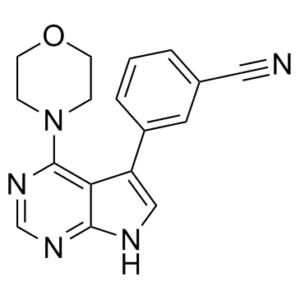PF-06447475 (PF06447475) is a novel, highly potent, selective and brain penetrable inhibitor of Leucine rich repeat kinase 2 (LRRK2) with anti-PD activity. It inhibits LRRK2 with IC50 of 3 nM. LRRK2 has been genetically linked to Parkinson's disease (PD) by genome-wide association studies (GWAS). PF-06447475 inhibits LRRK2 enzyme and LRRK2 in the whole cell assay with IC50s of 3 and 25 nM, respectively. Cells incubated with PF-06447475 alone (0.5, 1, 3 μM) or in the presence of ROT significantly reduces (S935)-LRRK2 kinase phosphorylation to control. PF-06447475 has the potential for the treatment of PD.
Physicochemical Properties
| Molecular Formula | C17H15N5O | |
| Molecular Weight | 305.33 | |
| Exact Mass | 305.127 | |
| CAS # | 1527473-33-1 | |
| Related CAS # |
|
|
| PubChem CID | 72706840 | |
| Appearance | Off-white to pink solid powder | |
| Density | 1.4±0.1 g/cm3 | |
| Index of Refraction | 1.711 | |
| LogP | 2 | |
| Hydrogen Bond Donor Count | 1 | |
| Hydrogen Bond Acceptor Count | 5 | |
| Rotatable Bond Count | 2 | |
| Heavy Atom Count | 23 | |
| Complexity | 457 | |
| Defined Atom Stereocenter Count | 0 | |
| InChi Key | BHTWDJBVZQBRKP-UHFFFAOYSA-N | |
| InChi Code | InChI=1S/C17H15N5O/c18-9-12-2-1-3-13(8-12)14-10-19-16-15(14)17(21-11-20-16)22-4-6-23-7-5-22/h1-3,8,10-11H,4-7H2,(H,19,20,21) | |
| Chemical Name | 3-(4-morpholin-4-yl-7H-pyrrolo[2,3-d]pyrimidin-5-yl)benzonitrile | |
| Synonyms |
|
|
| HS Tariff Code | 2934.99.9001 | |
| Storage |
Powder-20°C 3 years 4°C 2 years In solvent -80°C 6 months -20°C 1 month |
|
| Shipping Condition | Room temperature (This product is stable at ambient temperature for a few days during ordinary shipping and time spent in Customs) |
Biological Activity
| ln Vitro | With IC50s of 3 and 25 nM, respectively, PF-06447475 inhibits LRRK2 enzyme and LRRK2 in the whole cell assay[1]. Cells treated with PF-06447475 alone (0.5, 1, 3 μM) or with ROT significantly lower the phosphorylation of (S935)-LRRK2 kinase compared to control. Compared to untreated and control, PF-06447475 significantly preserves the nucleus morphology and ΔΨm of NLCs exposed to ROT. PF-475 considerably reduces ROS production induced by ROT to a level comparable to cells exposed to PF-475 alone[2]. | ||
| ln Vivo | Microgliosis in G2019S+ rats treated with PF-06447475 was significantly reduced to levels observed in wild-type rats. In confocal sections, the proinflammatory marker MHC-II, which is expressed on myeloid cells but not neurons, also seems to be less prevalent in G2019S+ rats given PF-06447475. In G2019S+ rats, treatment with PF-06447475 dramatically reduces the amount of CD68 cells recruited to the SNpc. PF-06447475 effectively inhibits the increased neuroinflammation linked to the expression of G2019S-LRRK2. TH expression in the dorsal striatum, which is in line with medication that lessens SNpc neurodegeneration[3]. Rats are able to tolerate PF-06447475 well[1]. | ||
| Animal Protocol |
|
||
| References |
[1]. Discovery and preclinical profiling of 3-[4-(morpholin-4-yl)-7H-pyrrolo[2,3-d]pyrimidin-5-yl]benzonitrile (PF-06447475), a highly potent, selective, brain penetrant, and in vivo active LRRK2 kinase inhibitor. J Med Chem. 2015 Jan 8;58(1):419-32. [2]. Neuroprotective Effect of the LRRK2 Kinase Inhibitor PF-06447475 in Human Nerve-Like Differentiated Cells Exposed to Oxidative Stress Stimuli: Implications for Parkinson's Disease. Neurochem Res. 2016 Oct;41(10):2675-2692. [3]. Leucine-rich Repeat Kinase 2 (LRRK2) Pharmacological Inhibition Abates α-Synuclein Gene-induced Neurodegeneration. J Biol Chem. 2015 Aug 7;290(32):19433-44. |
Solubility Data
| Solubility (In Vitro) |
|
|||
| Solubility (In Vivo) |
Solubility in Formulation 1: ≥ 3 mg/mL (9.83 mM) (saturation unknown) in 10% DMSO + 40% PEG300 + 5% Tween80 + 45% Saline (add these co-solvents sequentially from left to right, and one by one), clear solution. For example, if 1 mL of working solution is to be prepared, you can add 100 μL of 30.0 mg/mL clear DMSO stock solution to 400 μL PEG300 and mix evenly; then add 50 μL Tween-80 to the above solution and mix evenly; then add 450 μL normal saline to adjust the volume to 1 mL. Preparation of saline: Dissolve 0.9 g of sodium chloride in 100 mL ddH₂ O to obtain a clear solution. Solubility in Formulation 2: ≥ 3 mg/mL (9.83 mM) (saturation unknown) in 10% DMSO + 90% Corn Oil (add these co-solvents sequentially from left to right, and one by one), clear solution. For example, if 1 mL of working solution is to be prepared, you can add 100 μL of 30.0 mg/mL clear DMSO stock solution to 900 μL of corn oil and mix evenly. (Please use freshly prepared in vivo formulations for optimal results.) |
| Preparing Stock Solutions | 1 mg | 5 mg | 10 mg | |
| 1 mM | 3.2751 mL | 16.3757 mL | 32.7514 mL | |
| 5 mM | 0.6550 mL | 3.2751 mL | 6.5503 mL | |
| 10 mM | 0.3275 mL | 1.6376 mL | 3.2751 mL |
